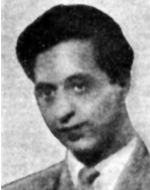Steller, Shlomo (Siggy, Siegfried, Sydney)
Son of Leah and Moshe Ya’akov, was born on 18.8.1924 in Vienna, the capital of Austria. When he was six years old, he died from his father. His mother was busy all day in her shop and worried about supporting her little son and daughter, so Shlomo was educated by his aunt to be loyal to the Jewish tradition. After the annexation of Austria to Nazi Germany, the brother and sister were removed in 1939 in a youth convoy to England. For a while they lived in short and difficult conditions in an institution for refugee children and eventually had to accept the generous invitation of a Christian family and move to their home. Shlomo studied radio technicians in a technological school. In 1944 he volunteered from England to the newly formed Jewish Brigade. He served in Italy and participated in battles against the Germans. After the victory, he served in Austria as an interpreter for the Intelligence Service of the British Occupation Force. He helped as much as possible to She’erith Hapleitah and tried to find his mother’s traces, but in vain – she was not saved from the extermination camp. His bitterness increased when he returned to England after his release and when he discovered that his sister had converted, he stopped all contact with her. In order to prevent the recurrence of such disasters in Jewish families in the future, it was necessary in a Jewish homeland. In the winter of 1948, when news of the outbreak of the War of Independence arrived, he moved to France, volunteered for Machal (Overseas Volunteers), and in April 1948 he arrived in Israel in a convoy of volunteers and was attached to the Givati Brigade. He participated in the Latrun system and later in battles on the southern front. His unit clung to Hill 69 east of the coastal road to block the Egyptians’ movement there. The hill was captured on June 8, 1948, and the force began to barricade itself. On Tuesday, June 10, 1948, the Egyptians shelled the site and then attacked it with armored vehicles, causing enemy casualties, the collapse of the positions and the damage to the weapons. And other fighters were injured, in a battle that took place on Tuesday, June 10, 1948. On the 18th of Tishrei 5710 (18.10.1949) he was laid to rest in the military cemetery at Nahalat Yitzhak.
